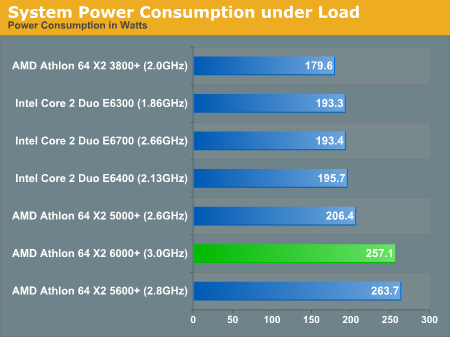AMD Athlon 64 X2 6000+: Competing with Aggressive Pricing
by Anand Lal Shimpi on February 20, 2007 3:37 PM EST- Posted in
- CPUs
Power Consumption
As always, we measured power consumption at two states: at idle sitting at the Vista desktop and under load while running our WME test. At both settings, Cool 'n Quiet/EIST were enabled to keep power consumption down to a minimum, although the biggest difference is made at idle.
Keep in mind that the X2 5000+ listed here is a 65nm Brisbane core, while the rest are 90nm parts. The X2 3800+ is a low power EE SFF core, although still based on AMD's 90nm process; all of the Intel CPUs are 65nm.

At idle, AMD's power consumption is lower than Intel by a few watts. Keep in mind that our E6300 is a particularly bad sample so it showcases the worst possible power consumption for that particular processor.

Under load it's clear that AMD needs 65nm to be competitive with Intel as only the 65nm X2 5000+ is able to draw power similar to that of its Intel counterparts. Note that AMD is at a bit of a disadvantage here as it's running on a more power hungry nForce 590 SLI chipset compared to Intel's P965, but the power requirements at 2.8GHz - 3.0GHz on AMD's 90nm process are quite real.
AMD needs 65nm top to bottom in a bad way; not only will it help ease capacity constraints, but it will also keep AMD from turning into the power hungry chip maker that Intel once was.










34 Comments
View All Comments
defter - Wednesday, February 21, 2007 - link
The maximum measured 8800GTX power consumption is about 150W. NVidia has mentioned that absolute maximum is 180W. However, since this is a CPU review, it's logical to assume that they stressed only the CPU in "full load" power consumption test.poohbear - Wednesday, February 21, 2007 - link
wow so 260w load plus 50w for a 8800gtx, thats only 310wts! kinda strange when companies are selling 1kilowatt psus.:/poohbear - Tuesday, February 20, 2007 - link
i was gonna ask the exact same question. I wish they'd clarify that in the articles when they talk about power consumption. Is that 263wts under load for the 5600+ JUST for the cpu or the whole system? thanks for any of the writers who can clarify this 100%.JarredWalton - Tuesday, February 20, 2007 - link
Power reports are always for the entire system. Obviously, lower end GPUs would reduce total power requirements quite a bit, but in maximum load testing the stress is only on the CPU and not the GPU. Thus, the ~50W power difference is going to remain whether you're running an 8800 GTX or an X1300 SE. The latter would simply use probably 40-50W less total power.bamacre - Tuesday, February 20, 2007 - link
Add in OC'ing and Intel, still, jumps further in the lead.BladeVenom - Tuesday, February 20, 2007 - link
But most people don't overclock.ViRGE - Tuesday, February 20, 2007 - link
Many of the readers of this site do though. The C2D is so mind numbingly easy to overclock, it's hard to not do it.Roy2001 - Tuesday, February 20, 2007 - link
I agree. I never OCed before. But with E6400 it is so easy. I just changed FSB from 266 to 350, I have a 2.8Ghz C2D. No voltage change, no cooling change. That's easy.mino - Tuesday, February 20, 2007 - link
Not to mention 800FSB E4300 parts.2.66/333FSB is pretty much a safe bet on most boards.
Even 2.13 for $150 is nice with board at STOCK FSB!.
Who needs E6400 then :) (for stock performance).
poohbear - Tuesday, February 20, 2007 - link
well if a 2.4ghz C2D can beat a AMD64 @ 3.0ghz, then calling a C2D @ 3.2ghz (the average overclock from what im reading) the "king" processor is a monumental understatement. It'd rape the 6000+.